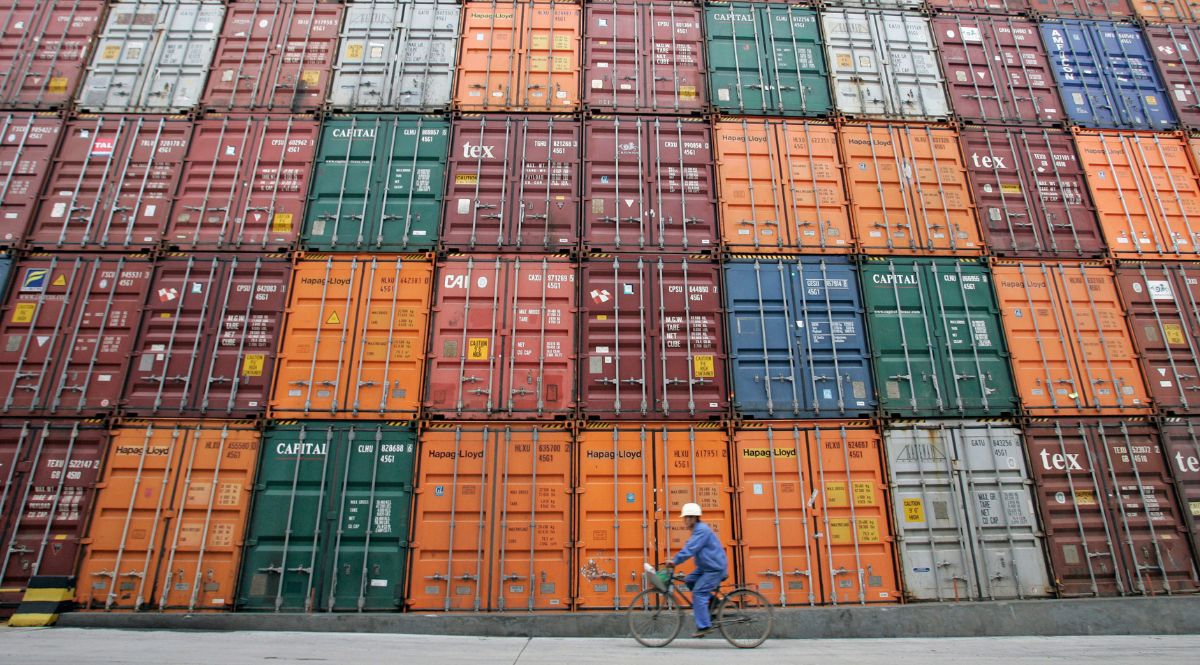U.S. Policy Shifting from Free Trade to "Fair Trade"
U.S. President Donald Trump and his aides have a negative view of the current free trade system. Their public grievances about its detrimental impact on certain groups of workers in the United States are confirmed by studies. The new administration is likely to seek profound changes in global trade, including basing the new system on bilateral arrangements and a deliberate lack of rigid rules. The main goal of the U.S. in the near future is probably going to be competition with China. The EU should support the U.S. in this brewing conflict if mutually beneficial rules for economic and security transatlantic cooperation can be established.
.png) DARREN HAUCK / Reuters / Forum
DARREN HAUCK / Reuters / Forum
Effects of Free Trade on the U.S.
The current world trade system is based on World Trade Organisation (WTO) rules and the pursuit of trade liberalisation. Importing countries, along with goods entering their markets, de facto accept the effects of the exporters’ internal economic policies, such as labour market organisation or subsidies. The system can therefore only work in a sustainable way if its participants coordinate domestic policies at least at a basic level. The WTO, created in 1995 has been based on the assumption that its participants would refrain from radical interventions in the free market. This reality changed as a result of China’s accession to the organisation in 2001 and the country’s subsequent rapid economic growth, as well as the basing of development models of certain countries (e.g., Germany) on export competitiveness. With low trade barriers, the attractiveness of the dollar as a reserve currency, and weak domestic demand resulting from low wages in exporting countries, the U.S. became a consumer of global manufacturing surpluses.
The influx of subsidised manufactured goods resulted in low inflation in developed countries, including the U.S. (accompanied, however, by uneven price increases across various categories of goods and services). Improved access to markets for U.S. export sectors has translated into opportunities for export-oriented job creation. The ability to offshore production proved beneficial to U.S. companies, which were able to lower operational costs and achieve higher profits or be more competitive via lower prices. Due to the reluctance of individual countries (especially China) to exchange the U.S. dollar for their own currency, which would lead to an increase in its exchange rate, a large proportion of U.S. trade deficits are reinvested in the United States, leading to increased capital availability in the country.
However, greater openness to trade has also led to job losses in manufacturing. According to the U.S. administration, there were around 17 million people employed in the manufacturing sector in 2000, but by 2010 (the lowest figure), just over 11 million. Today, manufacturing in the U.S. accounts for about 13 million jobs out of a total of about 160 million. Although some laid-off workers found employment in services, research confirms that the sudden loss of jobs following export competition translated into statistically reduced lifelong earnings. Some workers simply left the labour market altogether, especially in situations involving long-term local problems in which finding employment required a long-distance move. The negative economic impact translated into the social sphere, where the regions most affected by import competition from China experienced lower marriage rates, increased single parenthood levels, a higher incidence of children living in poverty, and increased mortality from drug and alcohol abuse. In turn, growing public frustration led to political effects, including increased polarisation resulting from a small but noticeable leftward shift for liberals but a larger rightward shift for conservatives, and a general shift in political preferences towards conservatism.
The “Fair Trade” Doctrine
Recognition of the problems with the free trade system led to attempts to correct it. The issue gained much attention during Trump’s first presidency. Some measures enacted during that time were left in place by Joe Biden, such as import tariffs. However, these actions were evolutionary, with the aim of achieving “free and fair trade” (the term used by the first Trump administration).
A radicalisation of the views of Trump’s inner circle is now apparent. As part of the Project 2025 initiative, experts considered altering the free trade system or moving away from it completely and toward building a “fair trade” system. A significant proponent of the latter idea, Peter Navarro, is now Senior Counselor to the President for Trade and Manufacturing in the new administration. The actions in the administration’s first weeks, especially the imposition of tariffs on Mexico, Canada, and China, and the repeated threats against the EU, indicate that a fundamental shift in U.S. trade policy towards this concept of “fair trade” is taking place.
The aim of the new trade policy is to balance U.S. trade by reducing or eliminating deficits and, as a result, stimulate industry, leading to the creation of well-remunerated jobs that will allow people without tertiary education to move into the middle class. This is to be done by rejecting the use of the Most Favoured Nation (MFN) clause, which is the cornerstone of the WTO rulebook and requires member countries to apply equal tariffs to every other member of the organisation. U.S. reluctance under Trump towards the WTO was already evident during his first term in office and led to paralysis of the organisation's dispute settlement system. The new U.S. authorities want instead to pursue active trade policy and arbitrarily differentiate tariffs in line with their political and economic interests, based on bilateral arrangements. Duties are to be aligned with those of trading partners—meaning differentiated—which will be a radical break with WTO rules. The uncertainty is exacerbated by the new U.S. authorities treating other public levies (e.g., VAT) as having the same effect as tariffs. Work is also underway to withdraw the MFN-like clause granted to China under domestic U.S. legislation.
Advocates of “fair trade” see China as an “existential threat” and trade problems as political rather than strictly economic. China is, in their optics, aiming for global domination, and its actions towards the U.S. (including trade barriers, dumping, non-compliance with intellectual property rights, currency manipulation) are considered to be outright aggression. The approach of “fair trade” advocates to China is one that is conflictual, assumes the uselessness of further negotiations, and views manufacturing and investment issues as matters of national security. The U.S. authorities demonstrated their commitment to this approach by, among others, the imposition of 20% additional import duties on Chinese goods in the very first weeks of the new administration.
Conclusions and Outlook
The effects of the free trade regime on the U.S. have generally been positive, but some Americans have lost out because of the changes over the past 30 years. Local economic problems caused by exposure to foreign competition have translated into social and political radicalisation. Although the U.S. economy and society also have other problems (severe income and wealth inequality, the polarising effects of social media), the negative effects of free trade have affected the voting preferences of U.S. citizens. A constructive approach to solving the associated problems should therefore be an important part of relations with this country.
The Trump administration will in all likelihood continue to push for a historic change in the world trade system, guided by the “America First” principle. Rules-based, long-term, stable cooperation will lose importance. Solutions will be worked out following unilateral U.S. action and bilateral arrangements. The need for the U.S. to work with its partners, especially in the context of the U.S.-China rivalry, the negative effects of tariffs on its own economy (e.g., rising inflation), and the reactions of financial markets will limit the scope of action of Trump’s administration. Trade policy has little chance of leading to profound changes for the society in the short term (e.g., massive reshoring of industrial jobs). Tariffs targeting specific countries are probably part of the political pressure in the lead up to negotiations on changes to the world trade regime. A full assessment of their effects will only be possible once the new arrangements have stabilised and the Trump administration rolls out a programme of reforms in domestic economic policy.
It is advisable for Poland to advocate for the EU and its Member States to pursue policies aimed at reducing trade surpluses with the U.S., including through domestic solutions. The EU should act as a bloc, as it is a common market and individual countries lack the scale for equal relations with the United States. It is necessary to remind the partners that the main source of global economic problems is the imbalances in the Chinese economy, and that, aside from balancing U.S.-EU relations, it is advisable to counteract this problem jointly.




.png)
.png)